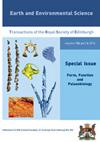大西洋中部火山岛蝙蝠化石记录的首次研究
IF 1.2
4区 地球科学
Q4 GEOSCIENCES, MULTIDISCIPLINARY
Earth and Environmental Science Transactions of the Royal Society of Edinburgh
Pub Date : 2021-12-03
DOI:10.1017/S1755691021000384
引用次数: 2
摘要
蝙蝠是生态系统中数量最多、最重要的哺乳动物之一。然而,它们的化石记录既稀少又脆弱,很难找到。因此,除了加那利群岛以外,在大西洋中部的火山岛上没有这一群的记录。本文研究了西班牙加那利群岛的第一个蝙蝠化石记录。研究的材料是在兰萨罗特岛的Cueva de los Verdes和耶罗岛的Cueva Roja两个第四纪熔岩管中发现的。并与现有标本进行了牙、肱骨形态及生物计量学分析比较。在我们的研究结果中,我们强调了大西洋中部岛屿特有的两个物种的第一批化石数据,Plecotus teneriffae和Pipistrellus maderensis,前者来自加那利群岛,后者来自亚速尔群岛,马德拉群岛和加那利群岛。我们还在兰萨罗特岛的化石记录中证实了Pipistrellus kuhlii的存在。马德龙和马德龙的牙齿形态与化石种群没有差异。在库希利猿人的例子中,加那利群岛和伊比利亚半岛的种群与来自中欧的种群相比,在顶廓线上表现出差异。对这些分类群的古生态学研究表明,这些岛屿形成时的栖息地与现在的栖息地相似。本文章由计算机程序翻译,如有差异,请以英文原文为准。
First study of the bat fossil record of the mid-Atlantic volcanic islands
ABSTRACT Bats are one of the most abundant and important mammals in ecosystems. However, their fossil record is scarce and fragile, making them difficult to find. Accordingly, there is no record of this group in the volcanic islands of the mid-Atlantic Ocean apart from the Canary Islands. This paper studies the first bat fossil record of the Canary Islands (Spain). The material studied is found within two Quaternary lava tubes, Cueva de los Verdes on Lanzarote and Cueva Roja on the island of El Hierro. The dental and humeral morphology and biometry are analysed and compared with current specimens. Among our results we highlight the first fossil data of two species endemic to the islands of the mid-Atlantic Ocean, Plecotus teneriffae and Pipistrellus maderensis, the former from the Canary Islands and the latter from the Azores, Madeira and the Canary Islands. We also confirm the presence of Pipistrellus kuhlii in the fossil record of the island of Lanzarote. No differences are observed between the dental morphology of the current and the fossil populations of P. maderensis and Pl. teneriffae. In the case of P. kuhlii, the populations of the Canary Islands and the Iberian Peninsula show differences in the paraconule with respect to the populations from central Europe. Palaeoecological studies of these taxa suggest that these islands presented a similar habitat when the sites were formed to the present-day habitat.
求助全文
通过发布文献求助,成功后即可免费获取论文全文。
去求助
来源期刊
CiteScore
2.00
自引率
0.00%
发文量
21
期刊介绍:
Earth and Environmental Science Transactions (formerly Transactions of the Royal Society of Edinburgh: Earth Sciences) is a general earth sciences journal publishing a comprehensive selection of substantial peer-reviewed research papers, reviews and short communications of international standard across the broad spectrum of the Earth and its surface environments. The journal prides itself on the quality of its graphics and photographic reproduction. The Editors are keen to encourage interdisciplinary papers and Transactions also publishes occasional special symposia and invited volumes of specific interest.
We are currently in the process of digitising the archive of RSE Publications, and the archive of the Transactions, dating back to 1788, will be available from the back issues link on this site.

 求助内容:
求助内容: 应助结果提醒方式:
应助结果提醒方式:


